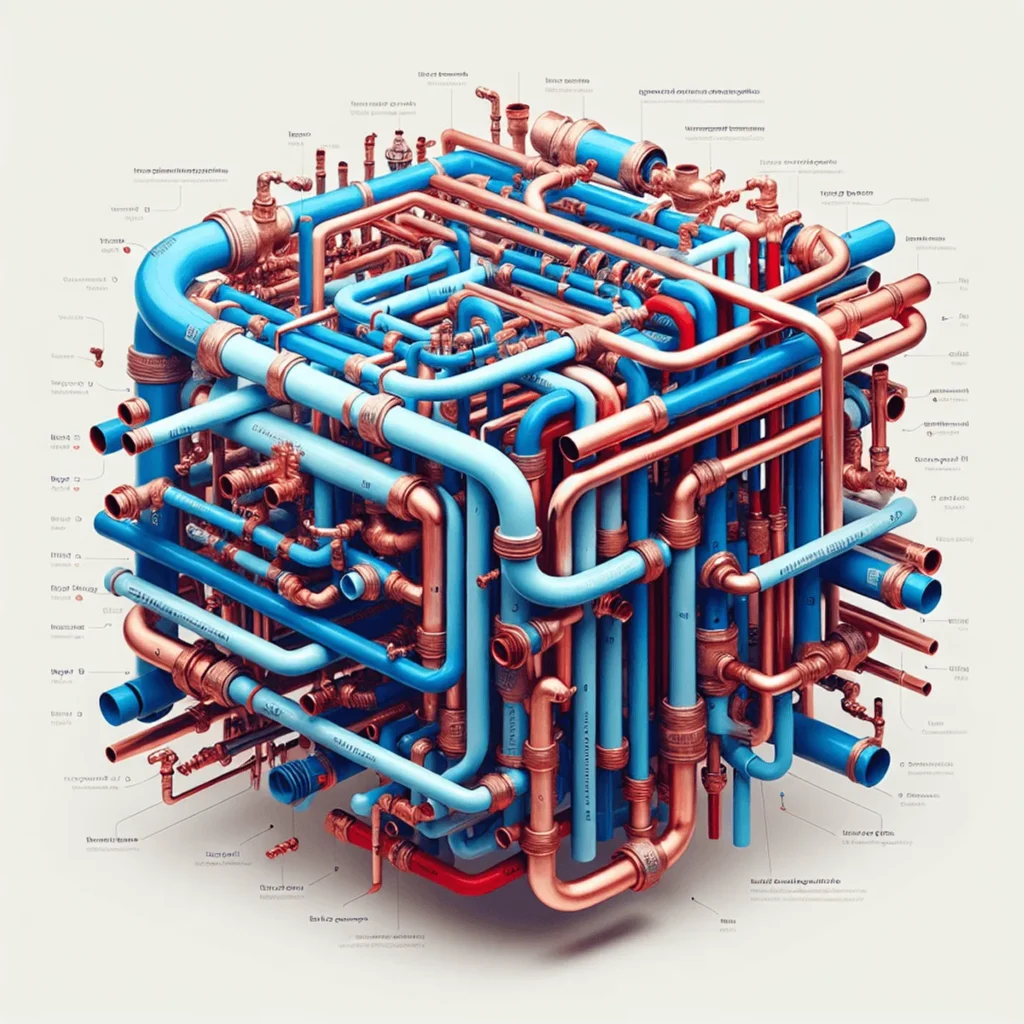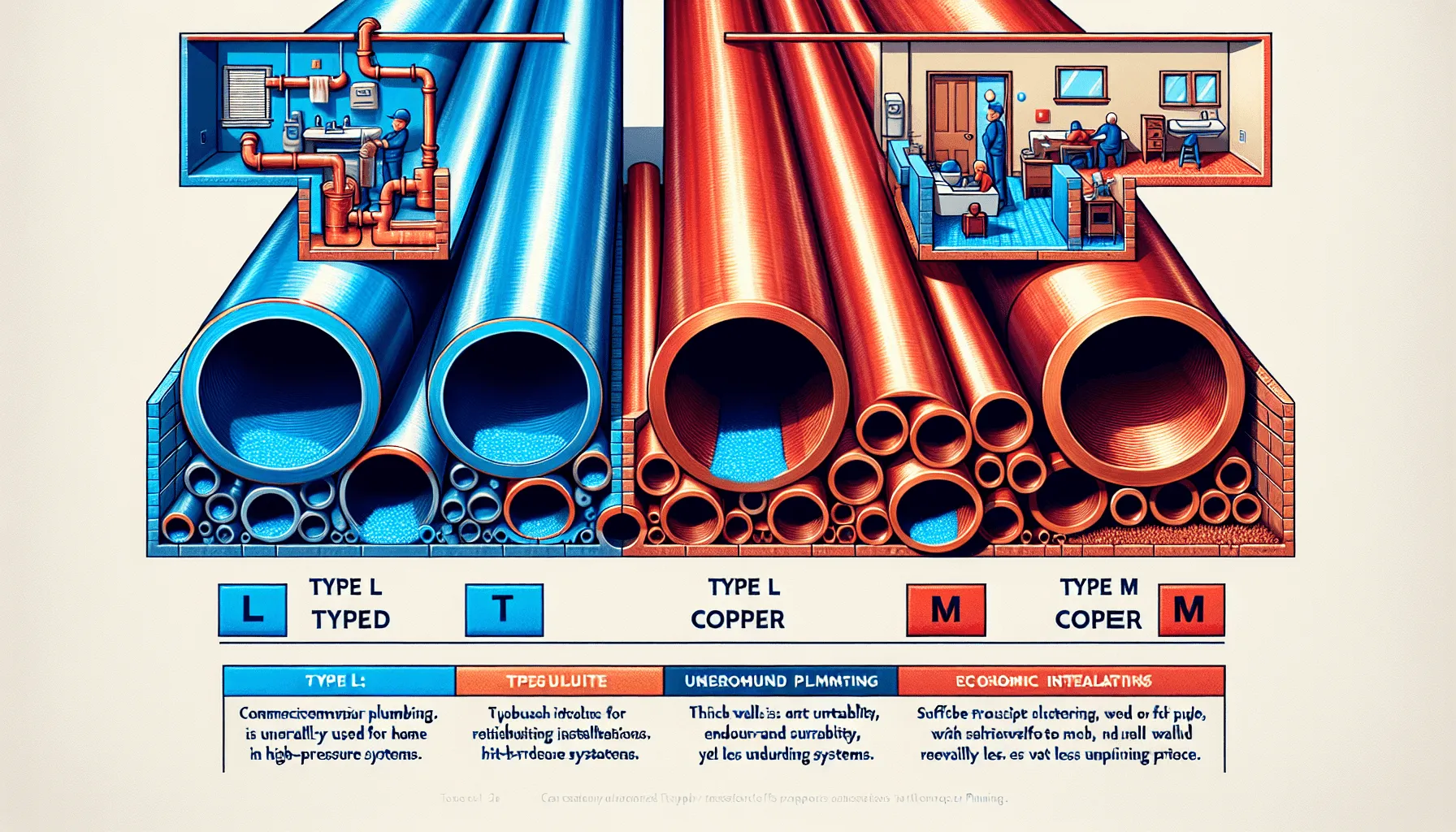When selecting copper pipes for your plumbing needs, understanding the difference between blue and red copper pipes is crucial. Blue and red labels represent Type L and Type M copper pipes, respectively—each with unique characteristics suited for different applications.
- Type L (Blue): This type of copper pipe has thicker walls, making it durable and capable of withstanding higher pressures. Type L is commonly used in underground installations, hot water systems, and commercial plumbing.
- Type M (Red): With thinner walls than Type L, Type M copper pipes are less expensive and typically used in residential plumbing. Though they suit general plumbing tasks, they may not be ideal for high-pressure environments.
Choosing the appropriate type of copper pipe ensures efficient water flow, longevity of the plumbing system, and compliance with local building codes. Incorrect selection can lead to frequent repairs, increased costs, and potential safety hazards. Understanding these key differences helps you make an informed decision tailored to your specific plumbing requirements.
Understanding Copper Pipe Types
When it comes to plumbing, understanding the different types of copper pipes is crucial for making the right choice. Copper pipes are primarily categorized into several types based on their thickness and intended applications, with Type L and Type M being the most common.
Type L Copper Pipe
Characteristics:
- Wall Thickness: Type L copper pipes have a thicker wall compared to Type M.
- Durability: Known for higher strength and durability.
- Pressure Ratings: These can handle higher pressure, making them suitable for various demanding applications.
Applications:
- Underground Installations: Due to its thicker wall and durability, Type L is often used in underground plumbing where additional strength is required.
- Hot Water Systems: Ideal for hot water lines because they can withstand high temperatures and pressures.
- Commercial Plumbing: Utilized in commercial settings where the demand for water pressure is higher.
- Gas Lines: In some areas, Type L is also approved for gas lines due to its robustness.
Type M Copper Pipe
Characteristics:
- Wall Thickness: Thinner walls compared to Type L, making it lighter and easier to handle.
- Cost-Efficiency: Less expensive, which makes it a popular choice for residential plumbing projects.
- Pressure Ratings: Suitable for standard pressure conditions found in typical household plumbing.
Applications:
- Residential Plumbing: Commonly used in homes for general plumbing tasks such as water distribution lines and drainage systems.
- Budget-Friendly Projects: Ideal for projects where cost is a significant concern without compromising on quality.
Other Copper Pipe Types
While Type L and Type M are the most prevalent, there are other types like Type K, known for its even thicker walls than Type L Type K is typically used for underground service lines or high-pressure applications where maximum strength is necessary.
Understanding these copper pipe types—Type L and Type M—allows you to make an informed decision based on the specific requirements of your plumbing project. Each type offers unique characteristics that cater to different applications within both residential and commercial settings.
Detailed Comparison of Type L and Type M Copper Pipes
Understanding the differences in wall thickness is crucial when comparing Type L vs Type M Copper Pipes.
Wall Thickness Differences
- Type L Copper Pipe: Known for its thicker walls, Type L copper pipe is designed to handle higher pressure and more demanding conditions. The increased wall thickness provides greater strength and durability.
- Type M Copper Pipe: This type has thinner walls compared to Type L. While it still meets standard plumbing requirements, it is less robust and not recommended for high-pressure situations.
Recommended: 15 Best Documentaries About Type L vs Type M Copper Pipes
Pressure Ratings and Their Implications
- Type L Copper Pipe: Due to its thicker walls, Type L can withstand higher pressure levels. This makes it suitable for applications such as underground installations and commercial plumbing where durability is essential.
- Type M Copper Pipe: With its thinner walls, Type M has a lower pressure rating. It is typically used in residential settings where the water pressure is moderate. Despite being less durable, it remains a cost-effective option for general plumbing tasks.
When deciding between these two types, consider the specific needs of your plumbing project. The wall thickness and pressure ratings are critical factors that will determine the longevity and safety of your plumbing system.
Color Coding in Copper Pipes: Understanding Blue and Red Labels
Copper pipes are often color-coded to help identify their type and applications quickly. This is especially critical for plumbers and contractors who need to make rapid decisions on the job.
Explanation of Color Coding in Copper Pipes
- Blue Label: This color coding indicates Type L copper pipes. The blue label is a quick identifier that the pipe has a thicker wall and is designed for higher-pressure applications. It signals durability and versatility, making it suitable for both residential and commercial plumbing needs.
- Red Label: The red label signifies Type M copper pipes. These pipes have thinner walls compared to Type L, making them less durable under high pressure but more cost-effective. The red label helps differentiate these pipes as more suited to general plumbing tasks within households.
What Blue and Red Labels Indicate in Terms of Pipe Type

Understanding the distinctions between blue vs red copper pipe labels can significantly impact your plumbing decisions:
Type L (Blue Label)
With its thicker walls, Type L is ideal for:
- Underground installations
- Hot water systems
- Commercial Plumbing
- Permitted gas lines
These pipes are designed for higher-pressure applications, which makes them suitable for various uses.
Type M (Red Label)
Due to its thinner walls, Type M is best used for:
- General residential plumbing
- Low-pressure applications
- Cost-sensitive projects where reduced strength is acceptable
Understanding these types of copper pipes can be further explored in resources such as the Copper Tube Handbook.
Recognizing these color codes simplifies the selection process, ensuring that you choose the right type of copper pipe tailored to your specific plumbing requirements.
Applications of Blue vs Red Copper Pipes in Plumbing Systems

Domestic Plumbing with Blue and Red Copper Pipes
When it comes to household plumbing, choosing between blue (Type L) and red (Type M) copper pipes depends on specific needs:
- Type L (Blue Copper Pipe): Ideal for high-pressure scenarios such as water supply lines, hot water systems, and underground installations. The thicker wall offers greater durability, making it suitable for long-term applications.
- Type M (Red Copper Pipe): Commonly used for general plumbing tasks like residential water distribution. Its thinner wall makes it less expensive and easier to work with, perfect for standard household plumbing where high pressure isn’t a concern.
Commercial Plumbing Applications with Blue and Red Copper Pipes
In commercial settings, the demands on plumbing systems can vary widely:
- Type L (Blue Copper Pipe): Often selected for commercial buildings requiring robust plumbing solutions. It’s well-suited for hot water distribution, HVAC systems, and gas lines where permitted by code due to its higher pressure ratings.
- Type M (Red Copper Pipe): Frequently used in commercial spaces that do not experience high-pressure conditions. It is economical for large-scale installations but may require more frequent replacement compared to Type L.
Specific Requirements for Gas Lines
Gas lines have stringent requirements:
- Type L: Generally preferred in gas line installations because of its thicker walls and higher pressure tolerance. Always verify local building codes as they dictate the acceptable types of pipes for gas lines.
Understanding the specific applications of blue vs red copper allows you to make informed decisions tailored to your plumbing needs.
Building Codes, Compliance, and Cost Considerations for Blue and Red Copper Pipes
Building Codes for Blue and Red Copper Pipes
Building codes play a crucial role in determining whether you should use blue (Type L) or red (Type M) copper pipes. Compliance with these codes ensures safety and reliability.
- Type L: Required for underground installations and high-pressure applications.
- Type M: Suitable for above-ground residential plumbing with lower pressure requirements.
Price Difference Between Blue and Red Copper Pipes
Cost is another significant factor when choosing between Type L (blue) and Type M (red) copper pipes. Generally, Type L pipes are more expensive due to their increased wall thickness and durability. The higher cost may be justified by their longer lifespan and ability to withstand higher pressures. In contrast, Type M pipes are less expensive but may require more frequent replacements, particularly in high-demand environments.
- Type L (Blue): Higher initial cost, longer lifespan, suitable for high-pressure applications.
- Type M (Red): Lower initial cost, shorter lifespan, best for standard residential plumbing tasks.
Additional Resources
For more detailed information on the specifications and applications of copper pipes, you can refer to the Copper Tube Handbook. Additionally, a comprehensive Specification Guide can provide further insights into the safe piping practices that should be adhered to when working with these materials.
Understanding building codes and cost considerations helps make an informed decision tailored to your specific plumbing needs.
Exploring Alternatives to Copper Pipes
When looking for alternatives to copper pipes, CPVC and PEX pipes are two popular options. Each has its advantages compared to traditional blue vs red copper pipe choices.
CPVC Pipe as an Alternative to Copper Pipes
Chlorinated Polyvinyl Chloride (CPVC) is a thermoplastic material that offers several benefits over copper:
- Cost-Effective: Generally less expensive than both Type L and Type M copper pipes.
- Corrosion Resistance: Unlike copper, CPVC does not corrode, making it suitable for aggressive water conditions.
- Ease of Installation: Lightweight and easier to cut and join, reducing labor costs.
PEX Pipe as an Alternative to Copper Pipes
Cross-linked Polyethylene (PEX) is another alternative that has gained popularity due to its flexibility and durability:
- Flexibility: Can be bent around corners without the need for additional fittings, which simplifies installation.
- Freeze Resistance: More resistant to bursting in freezing conditions compared to copper.
- Lower Cost: Typically cheaper than both Type L and Type M copper pipes.
Both CPVC and PEX are viable alternatives depending on your specific plumbing needs. While they offer several advantages, it’s essential to consider factors like compatibility with existing systems, local building codes, and long-term performance before making a decision. Additionally, exploring other types of plastic plumbing pipes such as PVC could provide further options, each with their unique set of advantages as detailed in this comprehensive guide.
Conclusion: Choosing the Right Copper Pipes for Your Plumbing Needs
When deciding between blue (Type L) and red (Type M) copper pipes, it’s crucial to match your choice with specific plumbing needs.
- For high-pressure systems, underground installations, or long-term durability, Type L is the preferred option due to its thicker walls and higher pressure ratings.
- For standard household plumbing where budget constraints are a consideration, Type M offers an economical yet effective solution.
Consider your project’s unique requirements to make the best choice between blue and red copper pipe.
FAQs (Frequently Asked Questions)
What are the key differences between blue and red copper pipes?
Blue and red copper pipes are color-coded to indicate their specific uses in plumbing. Blue copper pipes typically refer to Type L pipes, which have a thicker wall and higher pressure rating, making them suitable for water supply lines. Red copper pipes usually denote Type M pipes, which are thinner and often used for drainage or low-pressure applications.
What is the significance of choosing between Type L and Type M copper pipes?
Choosing between Type L and Type M copper pipes is crucial for ensuring the right pressure handling and durability in plumbing systems. Type L pipes are recommended for high-pressure applications due to their thicker walls, while Type M pipes are suitable for less demanding environments. The right choice impacts the longevity and safety of your plumbing.
How do the wall thicknesses of Type L and Type M copper pipes compare?
Type L copper pipes have a thicker wall compared to Type M pipes. This increased thickness allows Type L pipes to handle higher pressures, making them ideal for water supply lines. In contrast, Type M’s thinner walls make them more lightweight but less suited for high-pressure applications.
What do the blue and red labels on copper pipes indicate?
The blue label on copper pipes indicates that it is a Type L pipe, while the red label signifies a Type M pipe. This color coding helps plumbers easily identify the appropriate type of pipe for different applications based on their pressure ratings and wall thickness.
What are some common applications for blue and red copper pipes in plumbing systems?
Blue copper pipes (Type L) are commonly used in domestic plumbing systems, particularly for water supply lines due to their durability. Red copper pipes (Type M) are often used in commercial settings or for drainage applications where lower pressure is acceptable. Understanding these applications helps in selecting the right pipe based on specific plumbing needs.
Are there alternatives to copper pipes that I should consider?
Yes, alternatives such as CPVC (Chlorinated Polyvinyl Chloride) and PEX (Cross-Linked Polyethylene) can be considered. Both materials offer advantages over copper, including resistance to corrosion, lower costs, and easier installation in certain cases. It’s important to evaluate your specific plumbing needs when considering these alternatives.


Comments are closed